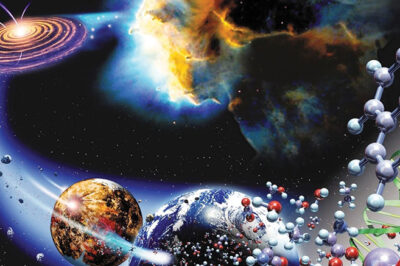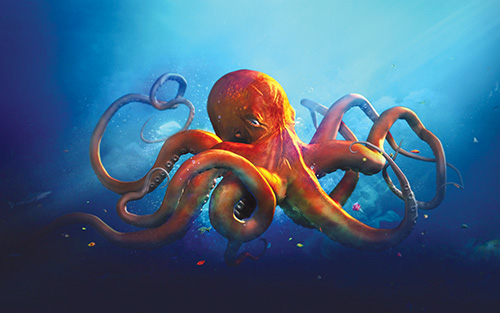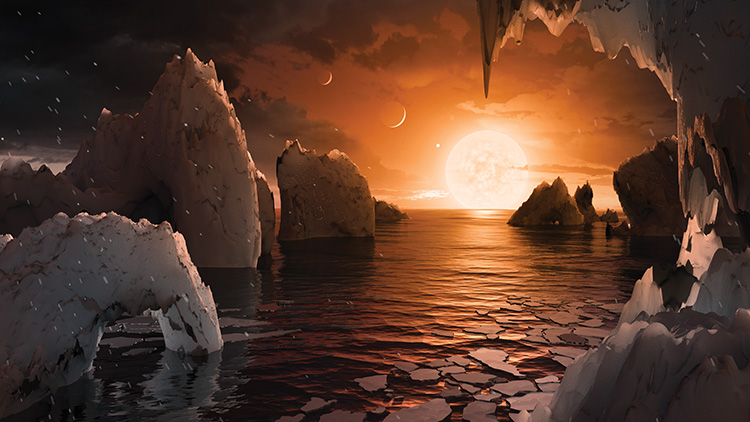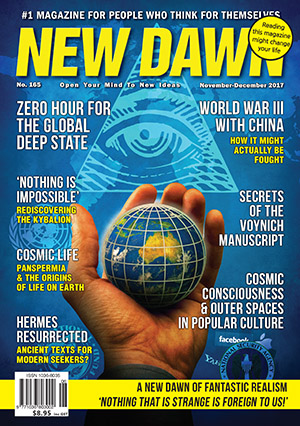From New Dawn 165 (Nov-Dec 2017)
If it can be firmly established that we are not alone in the Universe the implications for humanity will be profound. It could be even more important if we know that alien life in the form of microbes – bacteria and viruses – exist in our midst even now and continually rains down on our planet. Such microbes may sometimes cause devastating pandemics of disease, but more positively they have the potential to augment our genomes and over long intervals of time unravel an ever-changing panorama of cosmic life. In either case – whether as alien microbes in our vicinity or alien intelligence on distant planets – the acceptance of the emerging facts of cosmic life will mark an important turning point in human history.
The much publicised scientific developments of recent months – the conclusion of the successful Cassini Mission to Saturn, the Rosetta Mission to comet 67P/Churyumov–Gerasimenko (Comet 67P/C-G), the New Horizons Mission to planet Pluto, and the ongoing Kepler Mission to search for habitable planets – all spell out a single cosmic truth: Homo Sapiens as a sentient species appears to be hard-wired to seek out its cosmic origins, perhaps intuitively sensing that we are not alone.
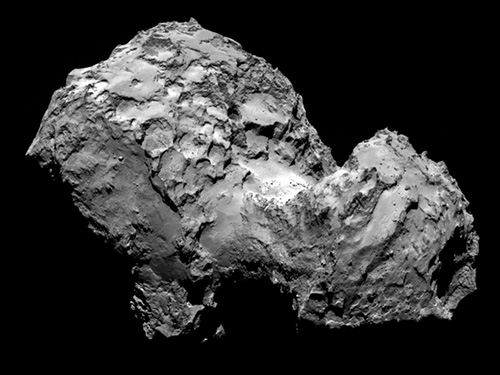
How did life arise? Not just on the Earth, but anywhere in the Universe? Does life emerge spontaneously on every Earth-like planet by processes involving well-attested laws of physics and chemistry? Or did the first-ever origin of life involve an extraordinary unrepeatable event involving stupendous volumes of the Universe in the most distant cosmological past? These age-old questions have recently acquired a new sense of urgency.
The primary requirement for the emergence of creatures like ourselves would be for the existence of rocky planets with water and an atmosphere generally similar to Earth. In 1995 Cambridge-based astronomer Didier Queloz together with Michel Mayor discovered definite evidence of planets outside our solar system. The first of these so-called exoplanets orbited a star 50 light years away in the constellation of Pegasus; it was a giant planet with a mass similar to Jupiter located too close to its parent star for any life to be possible. In 2009 NASA launched its orbiting Kepler telescope, which was specifically designed to discover planets that are the size of Earth. The detection process involved tracking down minute blinks (dimming) in the star’s light when a planet transited periodically in front of it during its orbit. At present nearly 4,000 definite as well as probable detections of habitable planets have been made within only a very small sampling volume of our Milky Way. Most of these planets orbit red dwarf stars that are on the average twice the age of our sun. Extrapolating from the sample of present detections, the estimated total number of habitable planets in our Milky Way galaxy is reckoned to be in excess of 100 billion. On many of these planets one might speculate that life may have begun, evolved, and perhaps long since disappeared.
Another related enterprise that has captured the news recently is the search for extraterrestrial intelligence using arrays of radio telescopes to scan the skies for evidence of intelligent signals. Over half a century ago Philip Morrison and Giuseppe Cocconi first drew attention to the possibility of searching the microwave spectrum of cosmic sources for intelligent signals and suggested particular frequencies as well as a set of potential targets. The SETI program (Search for Extraterrestrial Intelligence) began tentatively in 1960 and was first supported by NASA, and later by a host of private or semi-private entrepreneurs. Except for a single brief and mysterious “Wow!” signal discovered in August 1977, there has been a deathly silence across all of the prospective sources that have been scanned.
There could be a case for saying that the lack of progress in this venture was the result of organisations like NASA backing off. This may have been the thinking behind Russian billionaire Yuri Milner’s 100 million dollar SETI initiative that was recently announced with much pomp. Buying more telescope time, increasing the range of wavelengths, enhancing detector sensitivity and extending sky coverage have been argued as prerequisites if a breakthrough within a decade is to be achieved. But a positive result from SETI would be contingent on the emergence and widespread dispersal of primitive life capable of evolving into intelligent creatures. How often does this happen?
The idea that microbial life springs up de novo on billions of Earth-like habitable planets is an unproven, and most likely erroneous proposition. Such a belief is an extension of the canonical “primordial soup theory” for life’s beginnings on the Earth, which is a dogma with no hard evidence to support it. The dogma, in turn, can be traced back to the Greek Philosopher Aristotle (384–322 BCE) who proposed that life arose spontaneously from inorganic, inanimate matter whenever favourable conditions prevailed, e.g. fireflies from a mixture of warm earth and morning dew! Unfortunately, because of his stature as a philosopher, Aristotle’s views prevailed and still prevail almost to the present day. Experimental demonstrations against the validity of spontaneous generation have consistently been ignored, in particular, the 19th century experiments of Louis Pasteur showing that life at a microbial level is always derived from preexisting microbial life.
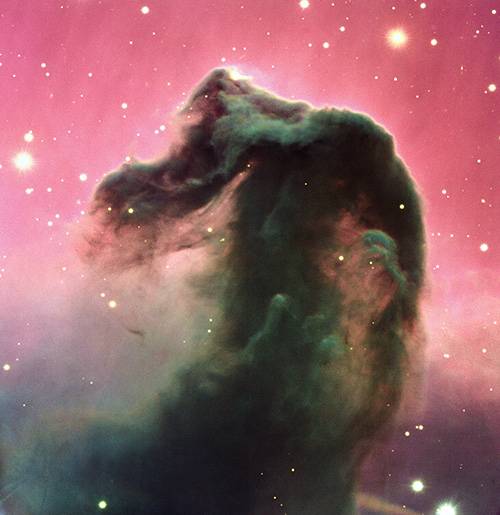
If there was a deep principle of nature that drove inorganic systems towards the emergence of primitive life – bacteria rather than fireflies – the evidence for this would have long since been discovered in the laboratory. With calculations showing grotesquely low a priori probabilities for the transition from non-life to life, only two options remain. The origin of life was an extremely improbable event that occurred on Earth (because we are here!) but will effectively not be reproduced elsewhere. In that case we would indeed be hopelessly alone. Or, a very much vaster cosmic system than was available on Earth, and a very much longer timescale was involved in an initial origination event, after which life was transferred to Earth and elsewhere by processes that the present writer and the late Sir Fred Hoyle proposed many years ago – panspermia. The essence of our theory of cosmic life is that the entire galaxy – perhaps the entire Universe – is one single connected biosphere. Physical transfer involving exchange of meteorites, comets, and dust with an intermingling of genes on a cosmological scale is far more probable than independent life origination events that are assumed in conventional science.
The discovery of microorganisms occupying the harshest environments on Earth continues to provide indirect support for this point of view. Transport of microbial life (and viruses) from one cosmic habitat to another requires endurance of space conditions for millions of years. The closest terrestrial analogue to this latter situation exists for microbes exposed to the natural radioactivity of the Earth. Quite remarkably, microbial survival under such conditions is now well documented. Dormant microorganisms in the guts of insects trapped in amber have been revived after 25-40 million years. And some species of bacteria have even been found to thrive in the interiors of working nuclear reactors. All this goes to show that arguments used in the past to discredit panspermia on the grounds of survivability during interstellar transport are seriously flawed.
If a single discovery is to serve as a watershed in the journey to accepting our cosmic origins, it is a recent study of two related species, the squid and the octopus. The squid has an antiquity in the geological record that goes back to the great metazoan explosion of multi-celled life 540 million years ago. The octopus apparently branches out from the squid line about 400 million years ago, presumed to evolve from an ancestral squid. Recent DNA sequencing of the squid and octopus genomes has exploded a bombshell. The squid contains a very meagre compliment of genes adequate to serve its modest survival needs. The emergent octopus, on the other hand, has over 40,000 genes (the human has only 25,000 genes) and many of these genes code for complex brain function. Others code for a highly sophisticated camouflage capability including rapid switches of colour. The octopus is incredibly more complex in structure and performance than its squid predecessor. Where did the suite of genes coding for complex brain function come from? They were not present in the ancestral squid or in any other living form that existed on the Earth at the time. The clear implication is that they came from outside the Earth – external to terrestrial biology – part of the cosmic milieu of life.
Another lead in this story has come from the study of interstellar dust clouds conducted over several decades. The list of organic molecules present in interstellar clouds has increased dramatically in number since their first discovery in the 1970s, and also has their degree of complexity. The first astronomical discovery showing interstellar (cosmic) dust to mimic closely the infrared absorption pattern (spectrum) of bacteria was made by Dayal Wickramasinghe and David Allen using the Anglo-Australian telescope. Decisive evidence for complex aromatic and aliphatic carbon-based molecules (ring molecules and long chain molecules) now exists everywhere in our galaxy, and even beyond in galaxies as far away as 8 billion light years. While all such data still tends to be interpreted avoiding “biology” with the suggestion that we may be witnessing exceedingly improbable “primordial soup-type events” on a cosmic scale, cosmic biology remains by far the most attractive logical option. This is further evidence of panspermia in action – the organic molecules in interstellar space being degradation products of itinerant bacteria and viruses.
Comets in our solar system have been targeted by several space missions since 1986 following ESA’s Giotto successful mission to Halley’s comet. The Giotto mission showed clearly that the prevailing theory that comets are dirty snowballs had to be abandoned in favour of comets rich in organic molecules, and most likely also containing viable bacteria and viruses.
More recent explorations of comets, culminating in the Rosetta Mission to Comet 67P/C-G, have yielded a formidable body of evidence all showing consistency with the existence in comets of microbial material. Many species of fermenting bacteria are known to be able to produce ethanol from sugars, so the recent discovery that Comet Lovejoy emits ethyl alcohol amounting to 500 bottles of wine per second would appear to be a clear indication that such a microbial process is operating.
The reluctance of some scientists to endorse these discoveries lies not in the quality of the data involved but in a desire to maintain a conservative position in relation to life on Earth and its purely terrestrial origins. It is only in this way that public funding of their research projects (and livelihoods!) can be assured. Although the Earth was demoted from its privileged position of physical centrality in the Universe over 500 years ago (and not without anguish), the trend to regard life as being centred on our home planet has persisted almost to the present day. But a paradigm shift with far-reaching consequences is imminent now, and public support also seems to be growing.
During the past decade, tantalising evidence of microorganisms currently entering Earth has accumulated but has been largely ignored and not pursued. This data was acquired from relatively inexpensive projects that involve balloon flights to the stratosphere and recovery of in-falling cometary dust. The first in a series of such experiments was conducted by the Indian Space Research Organisation in 2001 and 2006 with staggering results, indicating an inflow of microorganisms at the rate of a tenth of a tonne per year. Some years later a team of investigators at the University of Sheffield led by Milton Wainwright obtained very similar results. It is obviously of the utmost importance that these experiments are repeated by independent bodies, but this has not happened. More expensive and sophisticated investigations need to be carried out, even on the samples collected so far, if we are to prove beyond doubt that these microbes are unequivocally alien. The sad truth is that funding for such vitally important experiments is well-nigh impossible to secure. Compared with other Space Projects for solar system exploration, the budgets involved here are trivial, but the scientific and societal pay-off could be huge.
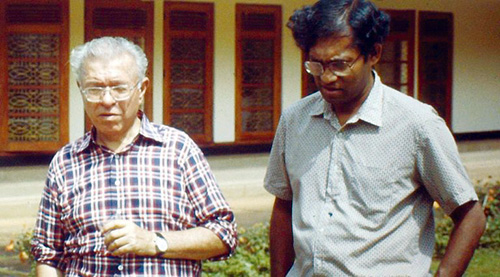
Our ultimate goal must be to confirm beyond a shadow of a doubt that life is a truly cosmic phenomenon. The evolution of life takes place not just within a closed biosphere on our minuscule planet Earth but extends over a vast and connected volume of the cosmos. It is to be expected on this basis that the emergence of intelligent life is a logical consequence of the same process and must, therefore, be commonplace on a cosmic scale.
The author’s book Cosmic Womb: The Seeding of Planet Earth (co-authored by Robert Bauval) explores the latest findings in support of a cosmic origin for humanity.
Further Reading
Chandra Wickramasinghe, The Search for our Cosmic Ancestry (World Scientific Publishing, Singapore), 2015a
Chandra Wickramasinghe, A Journey with Fred Hoyle (World Scientific Publishing, Singapore), 2015b
Chandra Wickramasinghe and Robert Bauval, Cosmic Womb: The Seeding of Planet Earth (Inner Traditions, USA), 2017
© New Dawn Magazine and the respective author.
For our reproduction notice, click here.

